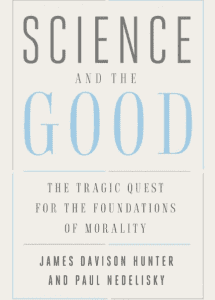 James Davison Hunter and Paul Nedelisky, in their new book called Science and the Good: The Tragic Quest for the Foundations of Morality, describe the “new sythesis” — that is, where people are today when it comes to morality in the pubic sector.
James Davison Hunter and Paul Nedelisky, in their new book called Science and the Good: The Tragic Quest for the Foundations of Morality, describe the “new sythesis” — that is, where people are today when it comes to morality in the pubic sector.
Perhaps the most important single chp in this book so far.
The Enlightenment led to this: “Science could explain what human beings were doing when they made moral claims, but the truth or falsity of those claims could never be empirically established and so must be ignored.”
Their summary:
The philosophical challenges [of evolution, utilitarianism, logical positivism] were formidable on their own terms. The scientific problems were equally daunting. After roughly two hundred years of effort, the science of morality had little to show: no empirical results provided any guidance toward peace among those in conflict, and no mechanics of human moral thought had become clear enough to enable political leaders to engineer flourishing societies. What people regarded as right, good, and virtuous remained a product of religion, contingent cultural currents, and basic intuition. The quest to find a scientific footing for morality languished.
But it was not over at all — it was E.O. Wilson’s well-known Sociobiology: The New Synthesis (1975) that set the trend of what they call “the new synthesis.” If natural selection favored the famous selfish gene/individualism, groups acted in altruistic ways in order to survive. Mapping these is the quest of Wilson.
Hunter and Nedelisky, however, point to an important foundation to the new synthesis:
The usually unmentioned but typically assumed big-picture view here is philosophical naturalism, or just “naturalism” for short. Recall that naturalism is the view that nature is all there is, a slogan made more precise as the idea that whatever exists can in principle be completely described in the language of science. On this sort of view, it obviously makes good sense to study morality scientifically.
They focus on four elements of where morality is today in this new synthesis shaped by microbiology and David Hume’s kind of psychology:
So the new synthesis fits hand-in-glove with the view that morality has its roots in moral psychology and thus can be ultimately explained by the scientific study of the mind. This new-synthesis view of morality has four basic elements:
And each is discussed succinctly and clearly.
(1) a Humean mind-focused sentimentalism,
A take-down statement: “)o people believe in human rights because such rights actually exist, or do they feel revulsion and sympathy when they read accounts of torture and then invent a story about universal human rights to justify their feelings? The Humean view is the latter: that what moral philosophers are really doing is “consulting the emotive centers” of their brains and then fabricating justifications for their feelings.”
(2) a Darwinian evolutionary account of why the mind has the traits it does…
Morality emerges from evolutionary developments, thus: “Human moral disagreement, for example, is a result of the conflict between the emotion-based moral psychology adapted for our ancestors’ hunter-gatherer lifestyle and the very different demands of modern life. We tend to react and judge the way we do, morally speaking, because of the survival value those reactions and judgments had during the late stages of our evolution. Our gut moral impulses, then, are the direct product of our evolutionary history.”
(3) a human interest-based utilitarianism about morality…
“As a rule, within the new moral synthesis, which course of action is “better” or “best” is a moral issue only insofar it is a practical one.”
[This got me to thinking of “best practices” in business that now have invaded the church. Is there a moral, theological basis for “best practices”?]
What does this all look like? “1. Identify a domain of practices. 2. Identify candidate norms for these practices. 3. Identify the appropriate goals of the practices in the given domain. 4. Evaluate the extent to which different practices accomplish the relevant goals. 5. Adopt as domain norms those practices that best accomplish the relevant goals.”
Presto! “Morality.”
All embedded within (4) a strident naturalism committed to empirical study of the world….
“The central idea of naturalism is roughly that the only things that exist are those that can be described in the language of science.”
So here we are today:
In the new synthesis, all efforts to understand morality tend to square with these elements. This configuration of views now appears to be more or less standard across disciplines studying the mind and is common in scientific or scientifically informed approaches to morality. The second source of novelty is the advanced technology offering deeper and more detailed empirical observation of the brain.
The goal is rather to figure out how best to secure objective improvement in satisfying people’s interests.











